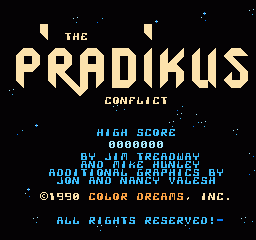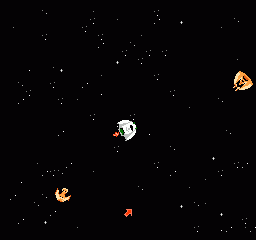Retro Replay Review
Gameplay
P’radikus Conflict delivers an engaging blend of classic thrust-based navigation reminiscent of the Asteroids series and a light resource-management layer that keeps every mission feeling high-stakes. You pilot your Lextorian starship through asteroid fields, enemy patrols, and treacherous orbiting debris, relying on inertia and careful thrust control to line up perfect shots. This old-school movement model encourages you to master momentum, strafing and reverse-thrust, transforming every dogfight into a delicate ballet of speed and precision.
(HEY YOU!! We hope you enjoy! We try not to run ads. So basically, this is a very expensive hobby running this site. Please consider joining us for updates, forums, and more. Network w/ us to make some cash or friends while retro gaming, and you can win some free retro games for posting. Okay, carry on 👍)
As a rookie captain, you’ll earn credits by destroying enemy vessels and completing secondary objectives such as liberating alien outposts. These credits form the backbone of progression, allowing you to purchase new weapon modules—shock waves, mines, atomic cannons—and vital upgrades like improved shielding, stronger hull plating and faster warp drives. The thrill of customizing your loadout for each mission gives P’radikus Conflict a strategic edge, as you weigh firepower against fuel capacity and shield strength.
Fuel management is where the game really shines in terms of tension. Each jump, boost and evasive maneuver saps your reserves, forcing you to plan pit-stops at nearby planets or abandoned satellites. Orbiting a friendly world to scoop up fuel and swap weaponry becomes its own mini-game, with the risk of surprise enemy encounters always looming. This constant balancing act between aggression and conservation keeps the gameplay loop both challenging and deeply satisfying.
Graphics
While P’radikus Conflict may not boast cutting-edge visuals by modern standards, its retro-inspired presentation has a unique charm. The game employs crisp 2D sprites and simple polygonal models for ships, set against richly colored nebula backdrops and starfields that scroll smoothly as you traverse the galaxy. The minimalistic HUD conveys vital information—fuel levels, shield strength, current credits—without obscuring the action, giving you full immersion in your cockpit.
Explosion effects, laser blasts and shock-wave detonations pop with bright flashes and dynamic animation, drawing your eye to the heat of battle. Each weapon type has its own visual flair: mines drift in space like menacing space-buoys, while the atomic cannon unleashes a pixelated mushroom cloud that feels appropriately over-the-top. Contextual background details—rotating space stations, moon rings, scattered wreckage—add variety to repeated mission locales.
The art direction embraces a muted color palette punctuated by brilliant highlights, lending the universe an otherworldly feel. Enemy ship designs are distinct enough to recognize at a glance, from nimble scout craft to lumbering capital ships. Although you won’t find photorealistic textures or real-time lighting effects here, P’radikus Conflict’s graphics support gameplay clarity and deliver a nostalgic aesthetic that many players will find endearing.
Story
The narrative premise of P’radikus Conflict is straightforward yet compelling: the once-peaceful Lextorians uncover P’radikus, a world rife with warring tribes who quickly turn interstellar after stealing advanced Lextorian technology. As their conquests spread across nearby systems, the Lextorian Council gathers their most promising pilot—you—to halt this bloodshed and, if necessary, deploy the secret Thunderbolt weapon to end the threat at its source.
Throughout your journey, a seasoned commander guides you via mission briefings filled with lore about the P’radikans, allied alien enclaves and the devastating potential of the Thunderbolt. Side missions to rescue enslaved species and sabotage enemy outposts flesh out the universe, encouraging you to see these clashes as more than just targets for loot. The promise of the elusive Toson Drive—the only propulsion system capable of reaching the P’radikus homeworld—drives the narrative forward and injects a sense of purpose into every hazardous sortie.
Dialogue is economical but effective, relying on mission logs and radio chatter to build tension. As you unlock deeper layers of the plot, you begin to question the morality of planetary annihilation, adding a subtle philosophical subtext to your campaign. While P’radikus Conflict doesn’t reinvent storytelling in games, its blend of interplanetary politics, rogue factions and doomsday weapons makes for a satisfying sci-fi backdrop that complements the combat-focused gameplay.
Overall Experience
P’radikus Conflict offers a rewarding mix of tight, skill-based piloting and light strategic planning that will appeal to fans of classic arcade shooters and space operas alike. The learning curve is approachable for newcomers yet deep enough to keep veterans engaged, thanks to the intricate thrust physics and upgrade paths that encourage repeated playthroughs. Every successful mission brings a rush of accomplishment, from narrowly evading an enemy cruiser to finally affording that next-tier warp drive.
The game’s pacing is well balanced: quieter stretches spent refueling and equipping your ship allow brief respite between high-octane dogfights, and the risk of fuel depletion adds a constant undercurrent of urgency. Though the graphics and sound design embrace a retro sensibility, they remain functional, evocative and perfectly attuned to the tone of a starfighter pilot’s struggle against overwhelming odds. This isn’t a visual showcase, but it doesn’t need to be—the gameplay does the heavy lifting.
Ultimately, P’radikus Conflict stands out as a hidden gem for players seeking a blend of resource management, mission variety and straightforward sci-fi storytelling. It may not compete with blockbuster space sims in budget or scope, but its combination of addictive combat loops, satisfying progression and engaging narrative hooks ensures a memorable journey through hostile star systems. If you’re craving an old-school space shooter with modern touches of customization and tactical depth, P’radikus Conflict could be your next favorite frontier.
 Retro Replay Retro Replay gaming reviews, news, emulation, geek stuff and more!
Retro Replay Retro Replay gaming reviews, news, emulation, geek stuff and more!







Reviews
There are no reviews yet.